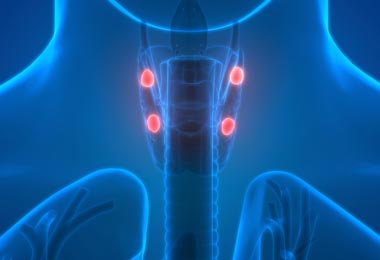Thyroidectomy
Thyroidectomy is surgical removal of all or part of the thyroid gland, which is located in the front of the neck. The thyroid gland releases thyroid hormone, which controls many critical functions of the body.
What You Need to Know
- Thyroid cancer, thyroid nodules and other conditions may require thyroidectomy.
- Once the thyroid gland is removed, the person takes replacement thyroid hormone to keep the body’s functions in balance.
- Thyroidectomy can be performed through an incision at the front of the neck, or through the mouth (scarless thyroidectomy).
Why might I need a thyroidectomy?
A thyroidectomy may be appropriate for people who have a thyroid tumor, thyroid nodules or hyperthyroidism, which occurs when the thyroid gland produces too much thyroid hormone.
Hyperthyroidism can be the result of an autoimmune problem, too much iodine in the diet, a benign tumor in the pituitary gland, too much thyroid medication, a swelling (goiter) in the thyroid gland or an inflammatory process.
What are the risks of thyroidectomy?
- Voice changes, such as hoarseness
- Sore throat
- Bleeding and blood clots
- Adhesions or scar tissue that require another surgery
- Injury to the esophagus or trachea (windpipe)
- Hypoparathyroidism (too little parathyroid hormone, which can result in abnormally low blood calcium levels)
What happens during a thyroidectomy?
Before the Procedure
The doctor will order imaging and laboratory tests, including:
-
Thyroid imaging with ultrasound, computed tomography (CT) or magnetic resonance imaging (MRI)
-
Blood test(s) for thyroid hormone levels and other factors
-
Examination of the vocal cords using an instrument called a laryngoscope
Just before your procedure, the surgical team may give you an antibiotic if you have a weakened immune system or other condition that makes you prone to getting infections. You may receive medicines to reduce nausea and vomiting (antiemetics).
For people with hyperthyroidism, the doctor will administer medications to keep thyroid hormones in balance during and after surgery.
Types of Thyroidectomy
Traditional Thyroidectomy
In the operating room, you will be in a semi-seated position, with or without your chin tilted back and with support under your neck and shoulders. Most thyroidectomies are performed under general anesthesia, meaning you are asleep and pain-free during the procedure.
The surgeon makes a small incision in the skin of the neck as close to a natural crease as possible to reduce the appearance of the scar. The surgeon parts a thin layer of muscle to gain access to the thyroid gland, then removes one or both lobes of the thyroid gland as well as any nearby lymph nodes that may be affected by disease.
The surgeon then returns the muscles of the front of the neck to their proper position and secures them in place. The skin is closed with sutures or glue.
Scarless (Transoral) Thyroidectomy
A newer technique involves accessing the thyroid gland through the mouth. This surgery leaves no visible scar since there is no incision on the outside of the neck.
Thyroidectomy: Recovery and Next Steps
In some cases, patients return home the same day as the surgery, but some people spend the night in the hospital. There, the team can observe the patient and monitor calcium levels in the blood.
When the thyroid gland is surgically removed, the body still requires thyroid hormone to keep vital functions in balance. Thyroid hormone replacement therapy involves taking synthetic or naturally derived thyroid hormones in pill form.






